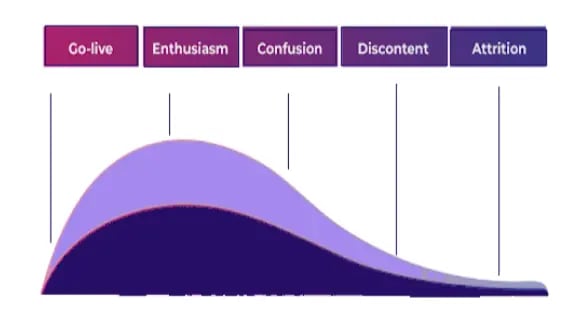“Progress is impossible without change, and those who cannot change their minds cannot change anything.” – George Bernard Shaw.
Progress and evolution are two words that are of prime importance for a business. An evolving business stands the test of time, engages and serves customer needs, and thus witnesses value in growing revenue. In this scheme of things, it is the right amalgamation of tools, processes, and people that makes the difference and ensures progress. But, the path from evolution to progress is paved by the word - adoption.
Salesforce is one such platform that is capable of bringing about a wide gamut of positive impacts for a business. However, what really gives businesses an edge is successful Salesforce adoption. A report says only 50% of enterprise CRM features are actively used by employees. Hence, complete and successful Salesforce adoption is one of the most crucial aspects for organizations worldwide.
In this blog, we will walk through the steps that are a few of the most important aspects to enhance your Salesforce adoption across teams and drive value.
-
Begin with knowing the system...
Identify gaps, fix and simplify it
The journey of improving and boosting salesforce adoption begins with identifying gaps, fixing systems, and bringing in simplicity. Two of the most common reasons why salesforce adoption faces a hit are:
-
The absence of an answer to the million dollar question - “What’s in it for me”
Salesforce data is as useful as the amount of information it is fed. A sales rep might begin diligently and keep filling in a plethora of information in custom and standard fields. But, they might eventually run out of patience and become lackadaisical in meticulously entering these details.
For executive leadership, the insights driven by this data are golden. It attunes forecasts about sales and helps underline the key trends in customer behavior, personas, and demographics. However, the sales reps' inability to access those insights to drive their own sales and opportunities via these inputs, makes this system look like just another tedious, irrelevant platform. Hence, organizations need to put workflows in place that enable a sales rep to access these detailed reports with ease.
-
User's inability to share frustration due to lack of channel of communication
Another cause of low adoption can be a lack of communication channels. Understanding how user groups interface with Salesforce, whether they are facing any challenges, whether they need more help, etc., are some of the questions that an organization should have answers to. Naturally, the best solution is talking to the end users. However, this is where the gap lies. Open communication can be tricky and can be even more challenging in the case of strict hierarchies. In most cases, employees are hesitant in expressing a long litany of pent-up complaints, if any, to their managers and leaders. This leads to only a partial view of the issues. This is where a partner like Srijan brings in tremendous value. An outside, unbiased neutral third party can easily facilitate conversations. They can help you conduct these audits.
-
Culture > tools, so align stakeholders
Buying-in leadership and nudging the users is how you turn the tide
The thought, “build and they will come” doesn’t really serve the purpose when it comes to technology adoption in an organization. Involving the stakeholders is crucial when making significant organizational changes. And in this attempt, your leadership becomes the flagbearer of this change.
For this, it is essential that you model impactful ways of leveraging Salesforce by the leaders. Their devotion to ace Salesforce will ensure a seamless buy-in from others in the org and simultaneously will enable you to reinforce the three key messages:
- Salesforce is here to stay
- It is beneficial for everyone
- Leaders are investing in making Salesforce work well for every user
Unless your leadership understands and supports the change, org-wide employees will not accept it either. Gathering support from senior-level team members is one of the most effective strategies to boost adoption. 
Salesforce Adoption Trends
It is your leadership’s enthusiasm for Salesforce that will lead by example. Their demonstration of a personal interest in using all of its features will motivate their team members to do the same. Leaders can show buy-in by starting conversations in chatter, sharing reports and insights made possible by analytics, regularly reviewing Salesforce adoption metrics with their team, and celebrating active users.
A knee-jerk introduction of an entirely new way for end-users to do their jobs can break the processes. Instead, a step-by-step growth model is what works with sales reps. This is important to be taken into consideration to avoid the above-mentioned gap that will creep up if this step is skipped during the initial phase. Understanding their concerns about how Salesforce might impact their day-to-day workflows and performance is therefore non-negotiable.
Consider creating a working group with key users from each department, team, and role. Augment that effort with a survey to all users to best understand what they need to get out of Salesforce and how it can better fit into their workflows. Using salesforce should seep in the company culture, only then can you expect a successful onboarding of stakeholders.
-
Train users & create value
As leadership leads by example and others follow, build a system that improves continuously
It is obvious that initially, your Salesforce users will not be able to master every feature. But their learning curve can be accelerated. Beginning with an introduction to the basics and easier-to-digest segments like managing their accounts and navigating the menu can be a valuable kickstart. Post which orgs can prioritize and map training according to what each team needs to do daily.
This will ensure a rapid increase in self-sufficiency and productivity as employees apply new information. So make sure that it is easy to access rather than buried in various folders and sources. If this is not done, the pieces of training covered in the past few days will be easily forgotten by users; out of sight = out of mind.
Moreover, organizations should conduct an audit of automation opportunities for at least a year. This also leads to maximizing Salesforce adoption. With regular audits, orgs help their sales teams improve productivity by automating repetitive but important administrative tasks.
Here are some of the automation processes that organizations can achieve with Salesforce:
- Data integration and exporting capabilities
- Workflow automation of internal procedures
- Approvals automation
- Adaptive business logic and strategy suggestion automation
Other custom automated actions tailored to your unique business needs.
Putting adoption points to action
To transform your business into a machine of excellence, you would need a technology partner who understands your business needs and can customize Salesforce. We, at Srijan, have worked as Salesforce implementation partners and have enabled businesses to streamline the processes that helped them climb the growth ladder, fast and steadily. To explore how we can customize Salesforce for your business, talk to us.
Our Services
Customer Experience Management
- Content Management
- Marketing Automation
- Mobile Application Development
- Drupal Support and Maintanence
Enterprise Modernization, Platforms & Cloud
- Modernization Strategy
- API Management & Developer Portals
- Hybrid Cloud & Cloud Native Platforms
- Site Reliability Engineering




